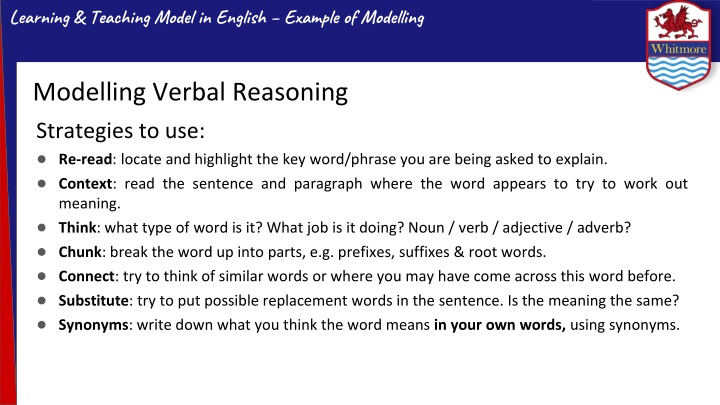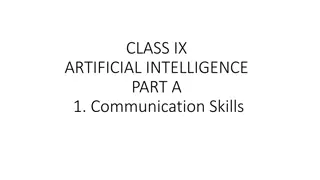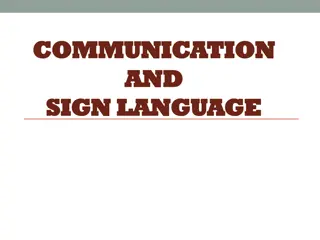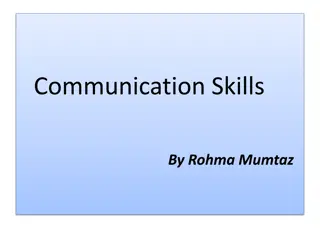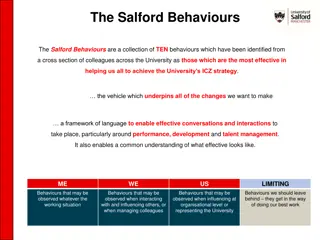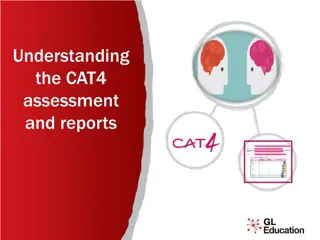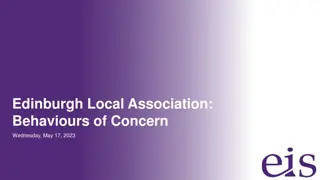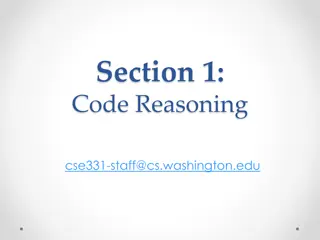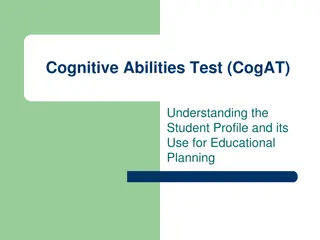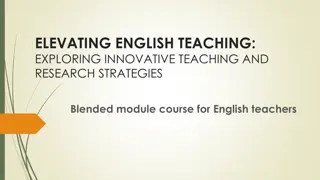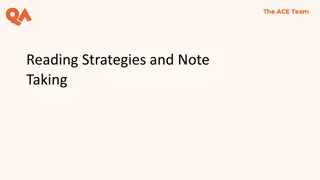English Teaching Model: Verbal Reasoning Strategies & Reading Behaviours
Explore a comprehensive English teaching model focusing on verbal reasoning strategies and reading behaviors. Learn how to analyze and interpret text, understand word meanings, and visualize concepts through engaging examples and practical exercises.
Download Presentation

Please find below an Image/Link to download the presentation.
The content on the website is provided AS IS for your information and personal use only. It may not be sold, licensed, or shared on other websites without obtaining consent from the author.If you encounter any issues during the download, it is possible that the publisher has removed the file from their server.
You are allowed to download the files provided on this website for personal or commercial use, subject to the condition that they are used lawfully. All files are the property of their respective owners.
The content on the website is provided AS IS for your information and personal use only. It may not be sold, licensed, or shared on other websites without obtaining consent from the author.
E N D
Presentation Transcript
Learning & Teaching Model in English Example of Modelling Modelling Verbal Reasoning Strategies to use: Re-read: locate and highlight the key word/phrase you are being asked to explain. Context: read the sentence and paragraph where the word appears to try to work out meaning. Think: what type of word is it? What job is it doing? Noun / verb / adjective / adverb? Chunk: break the word up into parts, e.g. prefixes, suffixes & root words. Connect: try to think of similar words or where you may have come across this word before. Substitute: try to put possible replacement words in the sentence. Is the meaning the same? Synonyms: write down what you think the word means in your own words, using synonyms.
Learning & Teaching Model in English Example of Modelling Modelling Verbal Reasoning Let s have a go together Read Text B: Making my skin crawl: Tattoos scream for attention by Tony Parsons. What does the writer mean by the phrase voluntary disfigurement ? Find and highlight the phrase in the text. What clues are there in the rest of the text? What might each word mean? Think of synonyms. Write your answer.
Learning & Teaching Model in English Example of Modelling Modelling Verbal Reasoning Attitude to tattoos Attitude to tattoos Attitude to tattoos is very negative is very negative is very negative ANSWER: voluntary disfigurement means people with tattoos make a choice to change their appearance for the worse / to damage or spoil their appearance We hear of victims of violence/war being disfigured Pre-fix dis- is a negative Suffix -ment is a condition or state A volunteer is someone who chooses to do something Root word figure means shape or appearance Seems to be referring to tattoos Must be a noun phrase (adjective + noun)
Learning & Teaching Model in English Example of Modelling Modelling the 8 Reading Behaviours Visualise Good readers use all five senses to create pictures in their heads. Try to see pictures that you can draw from the words you are reading. Good readers even reading the words. When they get to harder bits, they slow their voices down, or turn their voice up, so they can hear it better. When you read, try to hear your reading voice in your head. Visual Open Mind Fill the open mind with: Images of what you see when we re reading the text. Words to express thoughts about what we have read. Words to express how you feel (or how the writer wants you to feel) about what we have read. Be prepared to share at the end. Are there similarities or stark differences between your open minds? hear themselves
Learning & Teaching Model in English Example of Modelling GCSE English Language Reading Skills PEAL Structure for Inference & Analysis: Point: Signal to the examiner you are making a new point and refer to the question, e.g. The first impression we have is... Secondly the writer suggests... (keep this bit brief & concise) Evidence: Quote in quotation marks (individual words or short phrases) Analysis: Explain how this affects the reader (e.g. This implies... This suggests...) Language: Make sure you focus on individual words or techniques and the tone used.
Learning & Teaching Model in English Example of Modelling GCSE English Language Reading Skills Example of PEAL: The first impression we have of the badger is that he is perhaps a difficult creature to track down, for example it says a host of dogs and men go out and track the badger. The noun host implies many were needed to hunt the badger, which also suggests that it is possibly a formidable foe.
Learning & Teaching Model in English Example of Modelling GCSE English Language Reading Skills Scaffolding a PEAL response: Point: The first impression is... Secondly, it seems... Another impression is... Furthermore, the reader feels... Evidence: The use of the word ........... / For example ............ Analysis: This suggests / implies / makes the reader think/feel... Language: Try to include focus on individual words or techniques and the tone used
Learning & Teaching Model in English Example of Modelling GCSE English Literature Reading Skills Use PEAL to answer the question: How does Shakespeare present hatred in Act 1, Scene 1? PEAL (Point, Evidence, Analysis, Language) model: The hatred between the families is presented as something pervasive when Gregory says, The quarrel is between our masters and us their men . This suggests that every member of each household is expected to maintain the feud. The alliteration of masters and men emphasises that all are involved, creating dramatic tension for the audience in anticipation of the problems Romeo and Juliet s love affair will face. Alliteration = words that start with the same initial sound
Learning & Teaching Model in English Example of Modelling GCSE English Language Writing Skills Planning PAFT: Purpose: Why are you writing? What are you trying to achieve? Is it argumentation or persuasion? Audience: Who are you writing for? What do they need to know? How can you adapt your language for them? How formal does it need to be? Format: What are you writing? How should you lay it out? What language features should it include? How will you structure it? Tone: How should you write? What emotions will you try to communicate, e.g. humour, frustration, anger, excitement? How will you ensure this is appropriate for your purpose and audience?
Learning & Teaching Model in English Example of Modelling GCSE English Language Writing Skills Argumentation & Persuasion Planning High Five: 1. What are you writing about? Give an overview of the topic & introduce your point of view. Include 3 points that you will write about and a concluding sentence. The issue of ... is a controversial one because... 2. What is your first point? Expand in detail using evidence to support your views (PEE Point, Evidence, Explanation). Firstly, I believe... because... This clearly shows / Ostensibly, 3. What is your second point? Expand in detail using evidence to support your views (PEE Point, Evidence, Explanation). Furthermore, it is clear that... as can be seen by... which demonstrates 4. Give an opposing viewpoint and explode it. Some may think that... However, ... 4. Conclusion and recommendations: re-state your 3 points from the introduction. Therefore, I urge you to...
